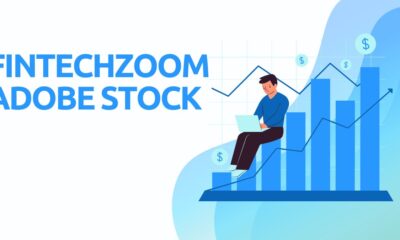BUSINESS
Dow Jones FintechZoom: Discovering the Power in Fintech World

Understanding Dow Jones FintechZoom
In today’s rapidly evolving financial landscape, staying informed is more crucial than ever. This is especially true for investors, Dow Jones FintechZoom enthusiasts, and business professionals who need to stay ahead of the curve. In this blog post, we’ll explore the dynamic synergy between Dow Jones FintechZoom, two giants in the realm of financial news and analysis. From the current state of the Dow Jones FintechZoom industry to the future of financial information services, this comprehensive guide will provide valuable insights and practical tips to help you make informed investment decisions.
Dow Jones, a name synonymous with financial information, has been a trusted source for investors and business professionals for decades. It provides a wealth of data, news, and insights that are integral to making informed financial decisions. Meanwhile, Dow Jones FintechZoom has emerged as a leading platform for fintech news and analysis, offering in-depth coverage of the latest trends and innovations in the financial technology sector.
Together, these platforms form a powerful alliance that enhances our understanding of the fintech industry and its impact on the financial world. Let’s take a closer look at the current fintech landscape and how these two giants contribute to it.
The Fintech Landscape
Understanding the current fintech landscape requires a close examination of the various elements driving its growth and transformation. From innovative startups to established financial institutions, the ecosystem is diverse and continually evolving.
Key Players in the Fintech Industry
Fintech is a broad sector that includes a range of services such as digital payments, blockchain technology, robo-advisors, and peer-to-peer lending platforms. Key players vary from well-known giants like PayPal and Square to emerging startups that are revolutionizing the way we handle financial transactions.
Technological Innovations
Technology is the backbone of fintech, driving innovations that make financial services more accessible, efficient, and secure. Developments in artificial intelligence, machine learning, and blockchain technology have paved the way for advanced analytics, more personalized financial products, and improved transaction security.
Regulatory Environment
As fintech continues to grow, so does the scrutiny from regulatory bodies. Navigating the complex regulatory landscape is crucial for fintech companies to ensure compliance and build consumer trust. Regulations differ significantly across regions, impacting how fintech companies operate and expand globally.
Consumer Adoption
The adoption rate of fintech services has seen a significant increase, driven by changing consumer preferences towards convenience and digital-first solutions. Understanding consumer behavior and addressing their needs is vital for the continued success and growth of the fintech industry.
Market Trends
Several trends are shaping the future of fintech, including the rise of neobanks, the integration of financial services into non-financial platforms (embedded finance), and the growing importance of sustainability and ethical considerations in financial products and services. These trends provide insight into where the industry is heading and what opportunities lie ahead.
Dow Jones’ Role in Financial Analysis
Historical Significance
Dow Jones has a storied history that dates back to 1882, when it was founded by Charles Dow, Edward Jones, and Charles Bergstresser. Over the years, it has established itself as a cornerstone of financial journalism and information. The Dow Jones Industrial Average (DJIA), a stock market index created by Charles Dow, has become one of the most widely recognized indicators of the financial health of the market.
Data-Driven Insights
One of the key strengths of Dow Jones lies in its comprehensive and reliable data collection. The platform offers an extensive array of financial statistics, historical stock market data, and economic indicators, which are invaluable for conducting thorough financial analysis. Investors and analysts rely on these data points to track market trends, evaluate investment opportunities, and make decisions based on factual evidence.
Real-Time News and Updates
In the fast-paced world of finance, staying updated with real-time news can make a significant difference in investment strategies. Dow Jones ensures that its users are constantly informed with breaking news, market updates, and expert opinions. This continuous stream of information helps investors to respond swiftly to market changes and capitalize on emerging opportunities.
Research and Reports
Dow Jones is also known for its in-depth research and analytical reports. These reports cover a wide range of topics, from market forecasts to sector-specific analyses, offering unparalleled insights to seasoned investors and newcomers alike. The rigorous methodologies and expert analyses presented in these reports provide a robust foundation for strategic decision-making.
FintechZoom’s Contribution to Fintech Innovation
FintechZoom has established itself as a pivotal player in the fintech industry, offering a wealth of information and analysis on the latest trends and innovations. Its unique position in the market allows it to provide comprehensive coverage of emerging technologies and their applications in financial services.
Comprehensive News Coverage
One of FintechZoom’s key contributions is its extensive news coverage, which spans a wide range of topics within the fintech sphere. From blockchain breakthroughs to advancements in artificial intelligence, FintechZoom ensures that its audience is always up-to-date with the latest developments. This timely and relevant information is essential for investors, fintech enthusiasts, and business professionals who need to stay informed about industry changes.
In-Depth Technology Analysis
FintechZoom goes beyond just reporting news; it offers in-depth analysis of the technologies driving the fintech revolution. Articles and reports delve into how innovations like machine learning, biometrics, and digital currencies are transforming the financial landscape. By providing detailed insights, FintechZoom helps its readers understand the potential impacts and applications of these technologies.
Thought Leadership and Expert Opinions
Another significant aspect of FintechZoom’s contribution is its focus on thought leadership. The platform features articles and opinions from industry experts, offering readers diverse perspectives on fintech trends. This expert commentary provides valuable context and can guide strategic decision-making for businesses and investors.
Educational Resources
Recognizing the importance of education in the rapidly evolving fintech sector, FintechZoom also offers a range of educational resources. These include webinars, whitepapers, and how-to guides designed to enhance understanding of complex topics. Whether you’re new to fintech or an experienced professional, FintechZoom’s resources can help you stay ahead of the curve.
Community Engagement
FintechZoom fosters a sense of community among its readers through interactive features such as forums, polls, and social media engagement. This community-centric approach encourages the exchange of ideas and experiences, further enriching the knowledge base of its audience.
By combining comprehensive news coverage, in-depth technology analysis, thought leadership, educational resources, and community engagement, FintechZoom significantly contributes to the ongoing innovation in the fintech industry.
The Synergy Between Dow Jones and FintechZoom
Complementary Strengths
The alliance between Dow Jones and FintechZoom draws on the complementary strengths of both platforms. Dow Jones, with its extensive historical data, comprehensive market analyses, and real-time news updates, provides a solid foundation for financial understanding. On the other hand, FintechZoom excels in covering the latest fintech innovations and disruptive technologies, offering unique insights into the rapidly evolving fintech landscape. Together, they form a robust information ecosystem that caters to the diverse needs of investors, business professionals, and fintech enthusiasts.
Enhanced Market Insights
By combining the resources of Dow Jones FintechZoom, users gain access to a wealth of information that enhances their market insights. Dow Jones’ reliable and detailed financial data, when paired with Dow Jones FintechZoom cutting-edge coverage of fintech advancements, provides a holistic view of the financial markets. This synergy enables users to not only stay informed about current market conditions but also understand the potential impacts of emerging technologies on traditional financial systems.
Improved Decision-Making
The integration of Dow Jones FintechZoom’s resources leads to improved decision-making for investors and business professionals. The comprehensive data and analyses support a more informed evaluation of investment opportunities and market risks. By leveraging the strengths of both platforms, users can develop more accurate forecasts and strategic plans, ultimately enhancing their ability to make well-founded decisions in a volatile financial environment.
Strategic Planning for Businesses
For business leaders, the synergy between Dow Jones FintechZoom offers valuable insights into market trends and industry developments. Dow Jones provides authoritative economic indicators and market analyses, while Dow Jones FintechZoom highlights the latest technological innovations and their potential business applications. This combined knowledge is crucial for strategic planning and staying competitive in an increasingly tech-driven financial sector.
Future Prospects
As the fintech industry continues to grow and evolve, the partnership between Dow Jones and FintechZoom will become even more significant. Their combined efforts will help users navigate the complexities of the financial landscape, offering the most up-to-date and comprehensive information available. The ongoing collaboration between these two giants promises not only to enrich the understanding of current financial trends but also to provide foresight into future developments, making it an indispensable tool for anyone involved in the fintech space.
The Future of Fintech and Information Services
Emerging Technologies Shaping the Future
As we look to the future, several emerging technologies are set to revolutionize the fintech landscape. Innovations such as blockchain, artificial intelligence (AI), and machine learning are already making a significant impact. Blockchain technology promises increased transparency and security in financial transactions, while AI and machine learning offer enhanced analytics and predictive capabilities. These technologies will continue to evolve, driving further advancements in the industry.
The Role of Data Analytics
Data analytics is becoming increasingly crucial in the financial sector. With vast amounts of data being generated every day, the ability to analyze and interpret this information is more important than ever. Advanced data analytics tools and techniques are enabling financial institutions to gain deeper insights into market trends, customer behavior, and operational efficiencies. This data-driven approach will be essential for staying competitive in the rapidly changing Dow Jones FintechZoom landscape.
Collaboration Between Traditional and Fintech Firms
The future of fintech will likely see increased collaboration between traditional financial institutions and fintech startups. By leveraging their respective strengths, these partnerships can drive innovation and deliver improved financial services. Traditional banks bring experience, regulatory knowledge, and customer trust, while fintech firms contribute agility, technological expertise, and innovative solutions. Such collaborations can foster a more dynamic and resilient financial ecosystem.
Regulatory Challenges and Opportunities
As fintech continues to grow, regulatory frameworks will need to adapt to ensure the stability and security of financial systems. Regulators face the challenge of balancing innovation with risk management, protecting consumers while fostering an environment conducive to technological advancements. The development of clear and effective regulations will be key to supporting the continued growth of fintech and ensuring its benefits are accessible to all.
The Importance of Cybersecurity
With the increasing digitization of financial services, cybersecurity becomes even more critical. Protecting sensitive financial data from cyber threats is a top priority for both fintech firms and traditional financial institutions. Investments in advanced cybersecurity measures and ongoing vigilance will be necessary to safeguard against potential breaches and maintain consumer trust.
Customer Experience and Personalization
In the future, customer experience will remain at the forefront of fintech innovation. Personalization, driven by data and AI, will enable financial services to tailor their offerings to individual needs and preferences. This focus on delivering a seamless and customized experience will be essential for attracting and retaining customers in a competitive market.
Sustainable Fintech Solutions
Sustainability is becoming an increasingly important consideration for the financial industry. Fintech firms are in a unique position to develop solutions that promote sustainability, such as green finance initiatives and environmentally friendly payment options. Embracing sustainability can drive positive change and appeal to a growing segment of environmentally conscious consumers.
The future of Dow Jones FintechZoom and information services promises to be dynamic and transformative. By staying informed about emerging technologies, regulatory developments, and market trends, businesses and investors can position themselves to thrive in this evolving landscape. The combined strengths of platforms like Dow Jones FintechZoom will continue to be invaluable in navigating the complexities of the financial technology sector.
Conclusion
In conclusion, the collaboration between Dow Jones FintechZoom offers a wealth of resources and insights for investors, fintech enthusiasts, and business professionals. By staying informed with these platforms, you can gain a competitive edge in the rapidly evolving financial landscape.
Whether you’re looking to stay updated on market trends, understand the latest fintech innovations, or make informed investment decisions, Dow Jones FintechZoom have you covered. Don’t miss out on the opportunity to leverage their expertise and stay ahead of the curve.
If you’re ready to explore the world of Dow Jones FintechZoom and financial information, sign up for Dow Jones FintechZoom today and start receiving the insights you need to succeed.
FAQs
What is Dow Jones FintechZoom?
Dow Jones FintechZoom, short for financial technology, refers to the integration of technology into offerings by financial services companies to improve their use and delivery to consumers. This includes a wide range of applications such as mobile banking, investment apps, and blockchain technology.
How does blockchain impact financial services?
Blockchain technology provides a secure and transparent way to conduct financial transactions. It operates as a decentralized ledger, reducing the risk of fraud and increasing the efficiency and security of financial transactions.
What are the benefits of using AI in fintech?
Artificial Intelligence (AI) can significantly enhance financial services through predictive analytics, personalized financial advice, and improved customer service. AI algorithms analyze vast amounts of data to provide insights and automate routine tasks, offering a more efficient and customized experience.
Why is data analytics important in the financial sector?
Data analytics is crucial because it helps financial institutions understand market trends, customer preferences, and operational efficiencies. Insights gained from data analytics enable more informed decision-making and foster a competitive edge in the market.
What is the role of traditional banks in the Dow Jones FintechZoom landscape?
Traditional banks bring regulatory knowledge, customer trust, and years of experience. As they collaborate with Dow Jones FintechZoom startups, these banks are able to leverage cutting-edge technologies and innovative solutions to enhance their service offerings and stay competitive.
How is cybersecurity addressed in Dow Jones FintechZoom?
Cybersecurity is a top priority in Dow Jones FintechZoom due to the increasing digitization of financial services. Fintech firms and traditional institutions invest in advanced security measures to protect sensitive financial data from cyber threats, ensuring the safety and trust of their customers.
How does Dow Jones FintechZoom contribute to sustainability?
Sustainable fintech solutions include green finance initiatives and environmentally friendly payment options. By developing these solutions, fintech companies can drive positive environmental change and attract eco-conscious consumers.
How can I stay updated on Dow Jones FintechZoom trends and insights?
To stay updated on the latest fintech trends and insights, consider leveraging platforms like Dow Jones FintechZoom. These resources provide comprehensive information on market trends, technological innovations, and regulatory developments in the financial technology sector.
BUSINESS
Seed Display Rack

A high-quality seed display rack offers the perfect way to present your seed packets to potential buyers. At CustomCraft UA, we create handcrafted plywood items on a custom order basis. Each of our pieces is an exclusive accessory, crafted at the intersection of traditional woodworking artistry and cutting-edge technology.
Advantages of Our Workshop’s Seed Display Racks
Our decorative wooden display stands for seeds will boost sales in your retail setting. Our collection features eco-friendly, adjustable display racks that elevate product presentation to the highest level of effectiveness.
For crafting our custom seed display racks, we use only premium-grade birch plywood. The materials undergo rigorous quality checks to meet our high standards, allowing us to provide our clients with products that:
- Will last for decades if kept in a dry, cool place;
- Are remarkably user-friendly, requiring minimal maintenance or repair;
- Are compact and lightweight, making them easy to transport and move.
In addition, we offer branded options, allowing seed racks to reflect a personalized aesthetic that enhances brand recognition and prestige.
We can propose our design ideas utilizing laser engraving on wood or create a completely custom look based on your specifications. We can add your logo, company motto, or owner’s initials, as well as any patterns or illustrations of your choice. We can even engrave your portrait to make an elegant and functional seed display rack.
Effortless Display Setup
Our plywood stands and display racks come in multiple levels and can include as many compartments as you need. Seed packets will be showcased attractively and accessibly on these stylish accessories, and thanks to carefully placed dividers, products won’t slip or spill, keeping everything neatly in place — something customers always appreciate.
Setting up our seed display rack requires minimal time and no special tools, making it easy for even a single salesperson to handle. This portability makes it the perfect pop-up display solution, as the rack can be set up or taken down efficiently and stored in a compact space due to its size.
Our mobile stands are ideal for craft fairs, farmer’s markets, and any temporary retail setup. We frequently provide custom plywood display racks to garden supply stores, farm markets, and health food stores seeking unique and practical display solutions.
BUSINESS
Skedpa Referral: Turn Your Network Into Cash with this Program

In today’s fast-paced digital world, freelancers, small business owners, and marketing professionals are constantly on the lookout for tools that can simplify their work processes and amplify their reach. Enter Skedpa referral, a versatile platform that’s gaining traction for its innovative approach to managing schedules and streamlining tasks.
But did you know that Skedpa also offers a referral program that can boost your income just by sharing what you love about their services? In this guide, we’ll explore how Skedpa referral program can be a game-changer for you, offering you insights into its benefits, sign-up process, and success stories from current users. Whether you’re new to Skedpa referral or a seasoned user, this article will give you the tools and tips you need to make the most of referrals and maximize your earnings.
What is Skedpa and How Does the Referral Program Work?
Skedpa is a robust platform designed to simplify scheduling and task management, making it ideal for freelancers, small business owners, and marketing professionals. It provides a range of tools that help organize appointments, manage projects, and communicate with clients efficiently. Skedpa’s user-friendly interface and powerful features make it a must-have for anyone looking to keep their business operations running smoothly.
The Skedpa referral program allows users to earn rewards by introducing the platform to new users. By sharing a unique referral link, users can encourage others to try Skedpa. When someone signs up using your referral link, both you and the new user receive benefits—often in the form of discounts, credits, or even cash bonuses. This not only adds value to your network but also helps spread the word about a tool that can make a real difference in business efficiency.
Participating in the Skedpa referral program is straightforward. It involves signing up for an account, generating your referral link, and then sharing it with your contacts. The more people you refer, the more rewards you can accumulate. It’s a win-win situation for everyone involved!
Why Skedpa is Beneficial for Freelancers, Small Business Owners, and Marketing Professionals
Freelancers, small business owners, and marketing professionals face unique challenges when it comes to managing their workloads. Skedpa addresses these challenges by offering features tailored to the needs of these groups. For freelancers, Skedpa simplifies scheduling client meetings and deadlines, ensuring that nothing falls through the cracks. Its intuitive interface allows for quick adjustments and easy tracking of ongoing projects.
For small business owners, Skedpa acts as a central hub for organizing team schedules and coordinating tasks. It enables seamless collaboration, which is crucial for businesses that rely on multiple moving parts to function efficiently. With Skedpa, everyone stays on the same page, minimizing the risk of miscommunication and delays.
Marketing professionals will find Skedpa particularly useful for campaign management. The platform offers tools for planning and executing marketing strategies, keeping track of key dates, and aligning team efforts toward common goals. By using Skedpa, marketers can ensure that campaigns are timely, cohesive, and effective.
How to Sign Up for the Skedpa Referral Program
Getting started with the Skedpa referral program is easy and takes just a few steps. First, if you’re not already a Skedpa user, you’ll need to create an account. This involves visiting the Skedpa website, entering your details, and setting up your profile. Once your account is set up, you’ll have access to all of Skedpa’s features.
Next, locate the referral section within your Skedpa account dashboard. This is where you’ll find your unique referral link. Simply copy the link and start sharing it with your network. The best part? You can share your referral link across various platforms, including email, social media, and even personal blogs.
Once someone signs up using your referral link, both you and the new user will receive rewards. These rewards can vary but typically include service credits, which can be applied to your own Skedpa account, or direct financial incentives. The more referrals you make, the greater the rewards!
Real World Success Stories from Skedpa Referrals
Many Skedpa users have found great success through the referral program, transforming their networks into valuable revenue streams. Take Julia, a freelance graphic designer, for instance. By sharing her referral link with fellow freelancers and business contacts, she was able to cover her subscription costs entirely through referral credits. This allowed her to reinvest her savings into growing her business.
Then there’s Mark, a small business owner who runs a local café. Mark encouraged his employees and friends to use Skedpa, highlighting its benefits for team scheduling. His efforts led to a substantial number of sign-ups, earning him a cash bonus that he used to upgrade his café’s technology infrastructure.
Similarly, Sarah, a marketing professional at a mid-sized agency, leveraged Skedpa’s referral program during a networking event. By promoting the platform’s capabilities to her peers, she not only introduced them to a valuable tool but also earned enough credits to further enhance her agency’s project management capabilities.
Tips for Maximizing Your Referral Earnings with Skedpa
To make the most of Skedpa’s referral program, it’s essential to adopt a strategic approach. Start by identifying potential users within your network who would benefit from Skedpa’s features. Focus on individuals and businesses that struggle with scheduling or project management, as they’re likely to appreciate the platform’s offerings.
Engage your audience by explaining how Skedpa has positively impacted your workflow. Share personal anecdotes and highlight specific features that have been game-changers for you. Authenticity goes a long way in convincing others to give Skedpa a try.
Don’t forget to utilize social media to expand your reach. Platforms like LinkedIn, Facebook, and Twitter are excellent for sharing your referral link with a broader audience. Be sure to craft engaging posts that capture attention and spark curiosity about Skedpa.
Finally, follow up with those who have expressed interest. Provide additional information about Skedpa’s benefits and address any questions they might have. This personal touch can make all the difference in converting interest into action.
Recap and Call to Action
Skedpa referral program presents an exciting opportunity for freelancers, small business owners, and marketing professionals to not only enhance their business operations but also earn rewards by sharing a tool they believe in. By understanding the program’s benefits, learning how to sign up, and implementing strategic referral tactics, you can unlock a steady stream of additional income.
In today’s competitive business landscape, leveraging tools like Skedpa can set you apart by increasing your efficiency and productivity. If you’re ready to take your business to the next level, consider joining the Skedpa referral program today. With its simple sign-up process and lucrative rewards, there’s no reason not to start sharing the benefits of Skedpa referral with your network. Get started now and watch your referrals—and earnings—grow!
Conclusion
In conclusion, Skedpa referral not only offers a robust suite of tools designed to streamline scheduling and enhance productivity but also provides a rewarding referral program that empowers users to turn their professional networks into additional revenue streams. The platform’s intuitive features cater to the unique needs of freelancers, small business owners, and marketing professionals, ensuring that projects run smoothly and efficiently. By participating in the Skedpa referral program, you not only help others discover a valuable resource but also gain benefits that can directly contribute to your own success. Embrace the opportunity Skedpa presents—take advantage of its powerful solutions, share them with your network, and watch as both your operations and rewards flourish.
FAQs
Q: How do I join the Skedpa referral program?
A: Simply sign up for an account on the Skedpa website if you haven’t done so already. Once enrolled, you can access the referral section in your dashboard to start sharing your unique referral link.
Q: What kind of rewards can I earn from the referral program?
A: Rewards typically include service credits applicable to your Skedpa account or financial incentives, which can vary based on the number of referrals you generate.
Q: Can I share my referral link on social media?
A: Yes, you can freely share your Skedpa referral link on social media platforms, emails, blogs, and more to reach a broader audience.
Q: Is there a limit to the number of referrals I can make?
A: There is no limit to the number of referrals you can make. The more referrals, the more rewards you can earn!
Q: How will I know if someone signs up using my referral link?
A: You will receive a notification within your Skedpa account dashboard once a referral sign-up is confirmed, along with an update on your earned rewards.
Q: What if I encounter issues with the referral program?
A: If you experience any difficulties or have questions about the referral program, reach out to Skedpa’s support team for assistance. They will be happy to help resolve your concerns.
BUSINESS
Andromeda VenFT crypto: Exploring the World of Crypto

The crypto world is buzzing with excitement, and at the heart of this conversation is Andromeda VenFT crypto. This groundbreaking innovation is weaving itself into the complex tapestry of the blockchain space, capturing the attention of crypto enthusiasts, tech investors, and blockchain developers alike. But what exactly is Andromeda VenFT, and why is it creating such a stir? This blog post aims to unravel the mystery behind Andromeda VenFT, exploring its applications, impact, and future potential.
Introduction to Andromeda VenFT crypto An Overview
Andromeda VenFT is not just another acronym in the vast sea of crypto terminology. It represents a new frontier in digital finance, blending the concepts of Non-Fungible Tokens (NFTs) with cutting-edge technological advancements to create a unique offering in the blockchain arena. Understanding its core function can provide valuable insights into its potential for transforming traditional and decentralized finance.
At its core, Andromeda VenFT operates on the principle of tokenizing assets, but with a twist. Unlike traditional NFTs, which are typically linked to digital art or collectibles, VenFTs aim to tokenize a broader range of assets. This includes financial instruments, real estate, and even intellectual property, offering a more diversified application across industries. The versatility of VenFTs makes them an attractive proposition for those looking to explore new avenues within the blockchain space.
With its robust framework, Andromeda VenFT promises to enhance transaction security, improve liquidity, and ensure transparency across all dealings. This innovation is set to redefine how assets are managed and exchanged in the crypto world, paving the way for more efficient and secure financial ecosystems.
Understanding the Role of Andromeda VenFT in the Crypto and Blockchain Space
The integration of Andromeda VenFT into the crypto ecosystem is a game-changer. It bridges the gap between traditional asset management practices and modern blockchain technologies, offering a seamless experience for users. By enabling the representation of real-world assets on the blockchain, VenFTs allow for more efficient trading, improved asset management, and enhanced security measures.
One of the key roles of Andromeda VenFT is in promoting decentralization. By tokenizing assets, it reduces the need for intermediaries, thereby cutting down on transaction costs and time delays. This decentralization fosters greater autonomy for users, allowing them to manage and trade their assets with minimal interference from third parties.
Additionally, Andromeda VenFT plays a crucial role in democratizing access to investment opportunities. By lowering the barriers to entry, it enables a wider audience to participate in markets that were previously inaccessible. This democratization is particularly beneficial for tech investors and blockchain developers, who can leverage VenFTs to diversify their investment portfolios and explore new technological frontiers.
Andromeda VenFT’s Impact on Traditional Finance and Asset Management
The traditional finance sector is not immune to the transformative power of Andromeda VenFT. Its ability to tokenize a wide array of assets presents significant opportunities for enhancing asset management processes. This innovation facilitates greater liquidity, enabling quicker and more seamless transactions across various asset classes, including stocks, bonds, and real estate.
By integrating VenFTs into asset management strategies, financial institutions can offer more tailored solutions to clients, enhancing customer satisfaction and retention. The transparency and security provided by blockchain technology further bolster trust in financial dealings, a critical factor for success in traditional finance sectors.
Furthermore, Andromeda VenFT is poised to revolutionize how financial institutions handle risk management. By providing real-time data on asset performance and market trends, VenFTs empower institutions to make more informed decisions, reducing the risk of financial loss and enhancing overall market stability. This represents a significant shift in the approach to asset management, one that aligns with the growing demand for more agile and responsive financial solutions.
Use Cases and Real-World Examples of Andromeda VenFT Implementation
The application of Andromeda VenFT crypto extends beyond theoretical constructs, with real-world implementations showcasing its potential. In the art world, for example, VenFTs are being used to tokenize physical artworks, allowing artists to retain ownership while still selling fractional shares to investors. This approach not only provides artists with new revenue streams but also offers investors access to a traditionally exclusive market.
In real estate, Andromeda VenFT is being leveraged to facilitate property transactions. By tokenizing real estate assets, buyers and sellers can engage in transactions with greater speed and efficiency. This not only streamlines the buying process but also opens up investment opportunities to a broader audience, including those who may not have the means to purchase entire properties outright.
In the intellectual property realm, Andromeda VenFTs are enabling creators to tokenize their work, ensuring they receive fair compensation for its use. This application is particularly relevant in industries such as music and film, where creators often struggle to monetize their content effectively. By utilizing VenFTs, creators can establish clear ownership rights and track the usage of their work, ensuring they receive due royalties.
The Future of Andromeda VenFT crypto Predictions and Potential Challenges
Looking ahead, the future of Andromeda VenFT crypto is brimming with possibility. Its potential to reshape industries and enhance financial ecosystems is undeniable. However, as with any emerging technology, it is not without its challenges. Regulatory hurdles, technological limitations, and market volatility are just a few of the factors that could impact its widespread adoption.
Despite these challenges, the outlook for Andromeda VenFT remains positive. Continued advancements in blockchain technology and increased interest from institutional investors are likely to drive further development and integration. As more industries recognize the benefits of tokenization, the demand for VenFTs is expected to grow exponentially.
To fully realize the potential of Andromeda VenFT, collaboration between stakeholders will be essential. This includes regulators, developers, investors, and end-users, all working together to create a robust and sustainable ecosystem. By addressing potential challenges head-on and fostering a collaborative environment, the future of Andromeda VenFT looks promising.
How Andromeda VenFT is Shaping the Crypto Landscape Expert Insights
Industry experts are closely monitoring the impact of Andromeda VenFT crypto on the crypto landscape. Many believe that its ability to bridge traditional finance with blockchain technology positions it as a catalyst for broader industry change. Experts highlight its potential to enhance market efficiency, increase liquidity, and promote greater transparency across financial ecosystems.
In interviews with leading blockchain developers and tech investors, a common theme emerges—Andromeda VenFT is seen as a key driver of innovation in the crypto space. Developers are excited about the possibilities for creating new decentralized applications (dApps) and exploring innovative use cases that leverage the unique capabilities of VenFTs.
Investors, too, are keenly aware of the potential returns offered by Andromeda VenFT. Its ability to open up new investment opportunities and diversify portfolios makes it an attractive proposition for those looking to capitalize on the next wave of blockchain advancements.
Conclusion The Importance of Andromeda VenFT crypto for Crypto Enthusiasts Tech Investors and Blockchain Developers
In conclusion, Andromeda VenFT crypto represents a significant advancement in the world of crypto and blockchain technology. Its ability to tokenize a diverse range of assets and enhance financial processes positions it as a valuable tool for crypto enthusiasts, tech investors, and blockchain developers alike. By offering increased efficiency, improved liquidity, and greater transparency, Andromeda VenFT is poised to reshape the landscape of digital finance.
For those interested in exploring the potential of Andromeda VenFT crypto, now is the time to act. By staying informed and engaged with the latest developments, stakeholders can position themselves to capitalize on the opportunities presented by this innovative technology. Whether you’re a crypto enthusiast looking to diversify your portfolio, a tech investor seeking new opportunities, or a blockchain developer exploring new avenues, Andromeda VenFT offers something for everyone.
FAQs
What is a VenFT?
VenFT, or “Venture Fungible Token,” is a type of digital asset that represents ownership or investment potential in various asset classes. It functions similarly to traditional securities but is facilitated through blockchain technology, enabling more efficient and transparent transactions.
How are VenFTs used in the art industry?
In the art industry, VenFTs are used to tokenize physical artworks, allowing artists to sell fractional ownership to investors while retaining control over their creations. This innovative approach provides artists with new ways to generate revenue and broadens the access of art investment to a greater audience.
What benefits do VenFTs offer in real estate transactions?
By tokenizing real estate assets, VenFTs enable faster and more efficient transactions between buyers and sellers. They offer a more accessible entry point for investors who may not be able to purchase entire properties, allowing them to buy and sell shares in a real estate asset instead.
What are the challenges facing the adoption of Andromeda VenFT crypto?
The adoption of Andromeda VenFT crypto can be hindered by several challenges, including regulatory uncertainties, technological limitations, and market volatility. Addressing these challenges requires collaboration among stakeholders, including regulators, developers, and investors, to ensure a robust and secure ecosystem.
Why is Andromeda VenFT important for the crypto landscape?
Andromeda VenFT is important for the crypto landscape as it bridges the gap between traditional finance and blockchain technology. By enhancing market efficiency, liquidity, and transparency, VenFTs have the potential to drive significant innovation and change in the financial industry.
-

 HEALTH1 year ago
HEALTH1 year ago3 Clothing Items That Are Secretly Ruining Your Health
-

 ENTERTAINMENT1 year ago
ENTERTAINMENT1 year agoWhat Does MyF Mean in Texting? A Guide for Gen Z and Parents
-

 TECHNOLOGY1 year ago
TECHNOLOGY1 year agoHow to Export CapCut Pro for Free: Unleash Your Video Editing Potential
-

 FASHION1 year ago
FASHION1 year agoWildskirt: Discover The Fusion of Fashion and Sustainability
-

 ENTERTAINMENT1 year ago
ENTERTAINMENT1 year agoInside viktor hovland daughter – The Daughter’s Tale
-

 LIFESTYLE1 year ago
LIFESTYLE1 year agoThe Ultimate Guide to Hosting Effective Corporate Events in Chicago
-

 ENTERTAINMENT1 year ago
ENTERTAINMENT1 year agoWho is NebraskaWut? A Deep Dive into the Heart of Nebraska’s Hidden Gem
-

 TECHNOLOGY1 year ago
TECHNOLOGY1 year agoA Deep Dive into fintechzoom adobe stock Impact











4 Comments